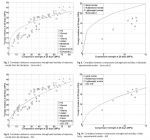On the use of European and American building codes with low-strength mortars
 The standard European building specifications, grouped in a nine-volume Eurocode, describe different approaches for determining the properties of commonly used building materials such as steel, aluminium, concrete, etc.
The standard European building specifications, grouped in a nine-volume Eurocode, describe different approaches for determining the properties of commonly used building materials such as steel, aluminium, concrete, etc.
The American Concrete Institute (ACI) also offers different reports concerning concrete structures (ACI 318R), lightweight concrete (ACI 213R) and the long-term mechanical behaviour (ACI 209R) of concrete. Those reports, used as building codes, are applicable when the properties and composition of the material respect various criteria.
All those materials that do not meet the scope criteria of Eurocode 2 or ACI reports because of their composition, property values or application cannot be used in the design of structures with those building codes. Regarding cement-based materials, concretes and mortars whose compressive strength is lower than the minima might not be useful for structures; however, they present an interesting potential for applications such as infrastructure materials, slabs-on-ground, etc. When designing structures and infrastructures in those materials, the accuracy of any formula offered by those building codes should be checked before being used.
This article compares experimental measurements and predictive formulas for the engineering properties (compressive and tensile strengths, modulus of elasticity). The results show that the addition of specific aggregates with low stiffness and strength modifies the relation between those engineering properties, thus reducing the accuracy of some of the predictive formulas suggested in ACI reports or Eurocodes.

